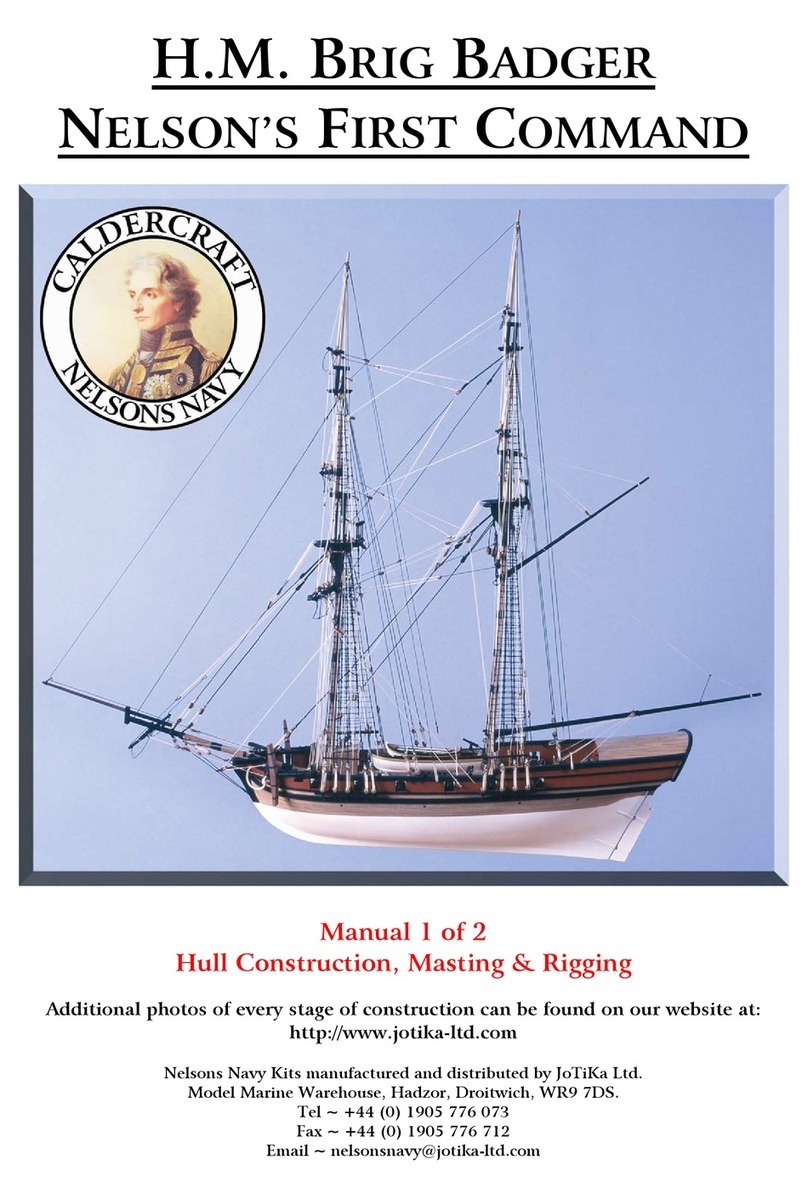
©2003 JoTiKa Ltd.
2
The Fore Topmast
In a similar manner to the lower mast, mark an octagon on the top of the topmast. Using a pencil, mark down the complete
length of the dowel all eight lines parallel to each other. Hold the pencil in a normal manner between thumb and forefinger and
using your middle finger as a guide, draw down the mast. This is a simple method which becomes very efficient and accurate
with a little practise. With the eight lines drawn down the mast, draw the octagon to the base of the mast also. These lines will
enable you to easily carve each of the octagonal areas onto the mast in-line with each other.
Using Plan Sheet 6 for reference, make up the topmast to the dimensions given.
Note: for the two octagons at the base of the topmast, the lowest (smallest) octagon is offset from centre so that the aft face
runs directly into the aft face of the second octagon above, as shown. All other octagons are central to the dowel. Also take
care in drilling the locating hole for the fid through the second octagon as shown, as this will be fitted into the notch on the fore
top trestletrees and if drilled at the wrong height will make correct alignment of the mast impossible. Beware not to fit the fid
at this stage or the topmast will not pass through the cap. All fids are made from 1.5x1.5mm walnut to a length of 5mm longer
than the width of their respective mast.
The octagon at the top of this mast is tapered from a diameter of 5.5mm to a diameter of 6.5mm along a length of 18mm. The
remaining 4mm of the octagon has a constant 6.5mm diameter.
The top 37mm of the mast is 4mm square. Two side faces of this square section should be inline with the two flat sides of the
centre octagon, where it will fit into the ‘top’, remembering that the lowest octagon is offset to the aft of the mast.
The sheave assembly can be made up as shown from 1.5x1.5mm walnut and a length of 1x4mm walnut however, the sheaves
should not be attached to the mast until the whole mast assembly, including the tops, has been glued together. This also applies
to the 0.5x1.5mm battens.
Identify the fore topmast trestletrees (139) and fore topmast crosstrees (210) and assemble the topmast top as shown.
The Fore Topgallant Mast
Using Plan Sheet 6 for reference, make up the topgallant mast to the dimensions given.
Mark the octagons and squares onto the mast as described previously, taking care that they are all in-line. Take care also with
the positioning of the fid.
With all three sections of the foremast constructed, the mast as a whole can be assembled.
Starting with the lower mast, identify the bibbs (344). Glue them into position as shown so that the straight back edge and the
top edge are flush with the cheeks.
With the mast banding fitted, glue the rubbing paunch of 2x4mm walnut to the front of the lower mast as shown 12.7mm off
the deck, taking care that it runs vertically and centrally, when in place it should be reduced to 1.5x4mm.
Assemble the fore mast boarding pike rack as shown on (Fig 030), and attach it to the mast, the base should be 10mm off the
deck and the top should be 25mm above the base. The lower mast banding can now be finished and when completed, the
boarding pikes can be glued into the rack. The pikes and pike racks are to be painted black.
Identify the foremast cap (66) and fore topmast cap (88). Dry fit the fore top and foremast cap to the lower mast. Do not
secure. Now dry fit the topmast, through the cap, insert the fid and position it into its locating notches on the trestletrees. Dry
fit the topmast top, topmast cap and topgallant mast in a similar manner. None of the individual components (lower mast,
topmast, topgallant mast, caps & tops) should be glued to one another at this stage.
With everything dry fitted together, manoeuvre the topmast to run parallel and in-line vertically with the lower mast, at the
same time, the lower top should remain parallel to the keel. When you are happy with the alignment, glue the lower mast,
lower top, cap, fid & topmast securely.
This process should be repeated with the topmast, topmast top, cap, fid and topgallant mast.
With the assembly complete, attach the bolsters, of 4x4mm walnut sanded or filed to quarter rounds as shown, to the lower top
and the bolsters, of 3x3mm walnut sanded or filed to quarter rounds as shown, to the topmast top.
Using lengths of 0.5x3mm walnut cut to 0.5x1.5mm attach the battens to the top square section on the lower mast as shown
(ensure the mast banding has been applied first). Also, secure the jeer block strop cleats (144) to the sides.
Identify the fore mast hand mast (149) and glue it into position between the crosstree and the underside of the cap. some
sanding of the top and bottom will be required to ensure a good fit and the centre section should be filed or sanded round.
The topmast sheaves, constructed earlier can now be fitted.
Identify the foremast cap saddles (348 & 349) and secure to the cap as shown on Plan Sheet 10 & (Fig 036). Finally locate and
fit the mast finishing cap (347).






























